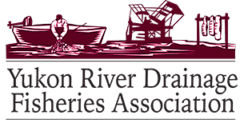Council Takes Action on Salmon Bycatch
Chinook Salmon Caps Will Be Reduced in Times of Low Abundance
At their recent meeting in Anchorage, the North Pacific Fishery Management Council (the Council) took action to reduce bycatch of both Chinook and chum salmon in the Bering Sea pollock fishery. Recognizing the precarious state of Western Alaska’s Chinook salmon stocks, the Council took a combination of actions which lower the caps in times of low abundance, combine Chinook and chum bycatch management, place additional requirements on industry incentive plans and reapportion the pollock catch between seasons. Cumulatively, the action is anticipated to reduce bycatch of both Chinook and chum salmon, and ensures that additional measures, including lower caps, are in place in years of low Chinook salmon abundance.
Much of the attention from both Western Alaskans and the pollock fishery focused on the option of lowering the hard cap (currently 60,000 Chinook salmon) and performance standard (47,591). Western Alaskans asked for a 60% reduction in both the hard cap and performance standard in testimony at the meeting and in hundreds of letters and resolutions submitted prior to the meeting. The pollock industry, on the other hand, was asking that no reductions be put in place. The State of Alaska led a strong charge to provide protections for Western Alaska salmon stocks. Commissioner Sam Cotten put forward a motion calling for a 35% reduction in the performance standard and a 33% reduction in the hard cap. Those numbers were successfully amended by Washington State’s representative to a 25% reduction in the hard cap and a 30% reduction in the performance standard. This lesser reduction is what passed in the Council’s final motion, 10-0.
This means that in years of low Chinook salmon abundance (defined as years in which the cumulative total Chinook salmon runs of the Kuskokwim, Upper Yukon and Unalakleet Rivers is at or below 250,000), the hard cap will be 45,000 and the performance standard will be 33,318 Chinook salmon. The pollock fishery manages to the performance standard, so the reduction in this number is important. The Council also made it very clear that they expect bycatch to remain well below the caps, and would take additional action if that was not the case. In recent years bycatch has hovered around 15,000 Chinook salmon.
While reductions in the cap levels drew most of the attention and almost all of the angst at this Council meeting, the Council’s action contains several other important features. The other pieces of the motion apply in all years – not just when salmon abundance is low. Alternative 2 combines Chinook and chum salmon bycatch management programs, ensuring a coordinated approach. It also requires information sharing with Western Alaska groups. Alternative 3 adds five new requirements for the industry Incentive Plan Agreements (IPA) to meet, including requiring salmon excluders, restrictions on bycatch rates in October (a time of historically high bycatch) and significant penalties (no fishing) for those with repeatedly bad bycatch performance. The options the Council selected under Alternative 4 allow the pollock fishery the flexibility to catch more of their harvest in the late A season, potentially shifting harvest effort away from the high bycatch times later in the year.
Overall, the Council’s action puts in place measures to further reduce bycatch in all times of abundance, and to ensure that in periods of low Chinook abundance the pollock fishery is limited to a lower level of bycatch. While we continue to believe that a greater reduction in the caps is necessary, we are happy to see these important steps forward in reducing bycatch and expect the pollock fishery to live up to the promises of their incentive plan agreements to reduce bycatch well below the caps.
